| 1 | The smallest rattlesnake species |
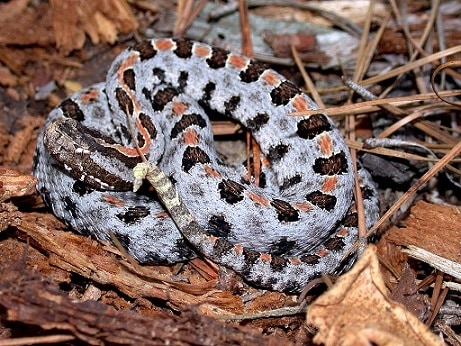
The east diamondback is the largest of North America’s 33 rattlesnake species. It’s a 1.5 metre long killer which occasionally reaches 2.4 metres, and hides in forest game trails waiting for innocent dog walkers to pass. The shortest rattlesnake, meanwhile, is the pygmy rattlesnake, the family’s equivalent of the tiny pygmy hippo in Africa.
Pygmy rattlesnakes clock in at just 38-58cm, with males and females exactly even in size. It’s a venomous species, but not nightmarishly so, as there are no adult human deaths on record. There are 3 subspecies, the most common being the Carolina pygmy rattlesnake. This version has a grey-blue base of scales, overlaid with blotchy black spots, each connected by a red stripe.
The western pygmy rattlesnake (eastern Texas and Louisiana) is slightly different, with less blue tinges, and a more solid grey instead. The dusky pygmy rattlesnake lives in Florida, and has noticeable red tinges to the grey base of scales. In all 3 subspecies, the belly is white with black speckles.
| 2 | Not endangered at all |
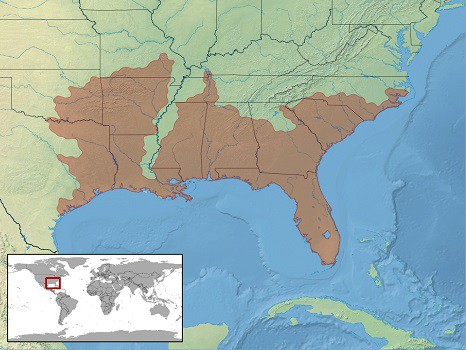
Pygmy rattlesnakes are a serpent of the southeastern USA. They inhabit every county in Florida except for the Florida keys, and also appear in Georgia, Alabama, Mississippi and Louisiana. Their most distant points stretch to North Carolina and eastern Texas. Pygmy rattlesnakes might encounter their eastern diamondback and timber rattlesnake cousins in the wild, but never the sidewinder or tiger rattlesnake further west.
Within this southern stronghold, pygmy rattlesnakes can appear in many habitats. They can lurk in sandhills or flatwood forests, reside on floodplains and wet savannah, or even relax by beaches and lakes. Unlike the critically endangered Louisiana pinesnake, the pygmy rattlesnake isn’t restricted to a narrow ecological niche whatsoever.
This is a rattlesnake which Florida dogwalkers commonly pass without realising. Compared to timber rattlesnakes, they stray into urban zones less commonly, but they’re not averse to slithering into a humid Florida garden. Golfers are often forced to shoe pygmy rattlesnakes away.
| 3 | The faintest rattlesnake rattle |
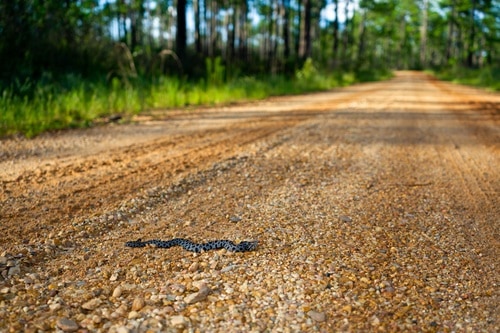
The rattle of this rattlesnake is barely a rattle at all. It’s more like the buzzing of a tiny fly. The pygmy rattlesnake easily has the weakest rattle of the 33 species, not because it’s the smallest and the rattle is correspondingly smaller, but because the rattles themselves are less developed.
Most rattlesnakes have segmented rattle scales made of tough keratin (like a rhino’s horn), which are spaced sufficiently apart to bash together as the snake shakes its tail. With the pygmy rattlesnake, there’s significantly less of those scales. 40% lack them altogether, while other scales break as the snakes age. The buzzing is usually only audible from 1 metre away.
It’s this weak rattle which has inspired the colloquial name of “buzzworm” in the southern USA. The sound is like a grasshopper, nothing exceptional in the humid undergrowth of Florida.
You can see the difference in pictures. Normal rattlesnakes have tails which suddenly change colour, like a finely carved musical instrument made traditionally from wood. With pygmy rattlesnakes, this rattle segment is noticeably shorter, occupying only the very tip.
| 4 | Preys on deadly centipedes |
Not only does the pygmy rattlesnake hunt down and eat centipedes, it hunts down and eats giant desert centipedes. This 15cm, caramel coloured arthropod is no joke, for humans or predators. It’s the largest centipede in North America and has potent venom of its own, featuring cardiotoxins and cytolysins. These can cause excruciating pain (though not death) in humans, and the venom itself comes from movable claws attached just behind its head.
In one study, scientists placed centipedes in the cages of 29 pygmy rattlesnakes. Compared to with skink lizards, the rattlesnakes were much more cautious, keeping a watchful distance. They approached with their heads held very high, to protect their vital organs from vicious defensive bites.
When they finally struck, the pygmy rattlesnakes immediately withdrew to keep themselves safe, allowing the venom to take effect. The centipedes took an average of 20 minutes to die compared to 6 minutes for the lizards. The rattlesnakes were forced to be inventive, with some biting the centipede by its tail and hurling it across the cage.
| 5 | Hides in rotting logs |
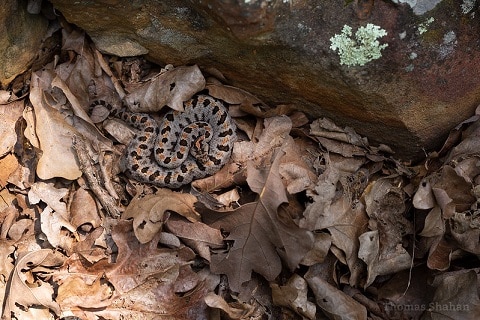
Pygmy rattlesnakes sleep in their own lairs, sometimes a mammal burrow, but more often a rotting tree surrounded by leaves. This comes in use for their hunting methods. Their classic strategy involves positioning their body parallel to a log, with their head raised up slightly. They’ll then wait patiently for a small mammal to run along the log, before snatching them up in a flash.
In grassy areas, meanwhile, they hide in the longer grasses, but only along the very edge. This gives them disguise, but also the freedom to grab prey scurrying along the adjacent short grass.
Pygmy rattlesnakes can sit by their logs all day without moving. They’re a very lazy species, rarely patrolling the forest on long expeditions just for the sake of it. In 1979, biologists released 50 pygmy rattlesnakes into the wild. Over the next 19.5 months, several males moved only 9 metres, and one female moved only 2 metres. One rattlesnake moved a more ambitious 227 metres, most likely to seek out freshly rotting logs to curl up in.
| 6 | Heat-seeking vision |
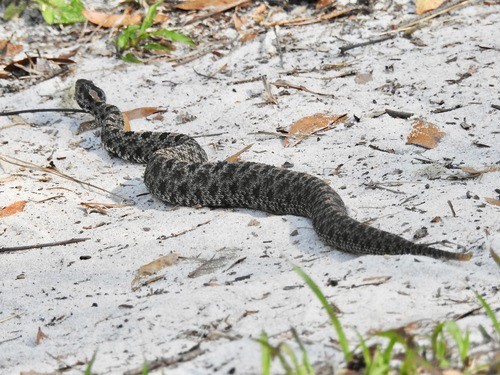
Pygmy rattlesnakes also utilise caudal luring, where they waggle their tails around to mimic insects, in order to tempt in prey. It’s mostly juvenile pygmies that do this, and consequently, juveniles have brighter coloured tails which fade as adults. This waggling is believed to be why the rattle evolved to be quieter.
Like all rattlesnakes, pygmies have heat-seeking pits in their heads which give them infrared vision. Pygmy rattlesnakes can detect a prey-environment temperature difference of just 0.5 degrees. Camouflage adds to the hunter’s package, but pygmy rattlesnakes aren’t infallible. One day, a biologist noticed a pygmy rattlesnake envenomating an anole. The snake waited patiently, but the anole fled up the higher branches of a tree, not realising that its doom was unavoidable.
The anole soon perished, but it was now completely out of reach for the pygmy rattlesnake. The slow venom was to blame, usually taking 15-20 minutes to kill reptiles and amphibians, versus 30 seconds for small animals.
| 7 | Nasty, but survivable venom |
Pygmy rattlesnakes are slap bang in the middle of the snake hierarchy for danger to humans. They have strong limitations, such as fangs which are merely 0.3-0.5cm long. That’s nothing compared to a newborn timber rattlesnake, at 2.6-3.8cm. Pygmy rattlesnakes have a short strike distance of 10-13cm, meaning that you’re most likely to be bitten by stepping on one.
Nobody has ever been killed by this rattlesnake, but a fully envenomating bite could still open the gates to 3 to 4 days of hell. There are no neurotoxins in the venom (like most rattlesnakes), but a hefty dose of cytotoxins and haemorrhagins. Pygmy rattlesnake venom was actually the source of the pharmaceutical drug eptifibatide, which has a very specific usage: preventing blood clotting in the middle of a heart attack.
Bite wounds typically redden and swell, often with blisters forming. The next level symptoms include trouble breathing and bloody urine. The LD50 toxicity rating is 2.8mg, which defeats two larger species: the red diamond rattlesnake (3.7mg) and the rock rattlesnake (9mg).
| 8 | Multiple bites per year |
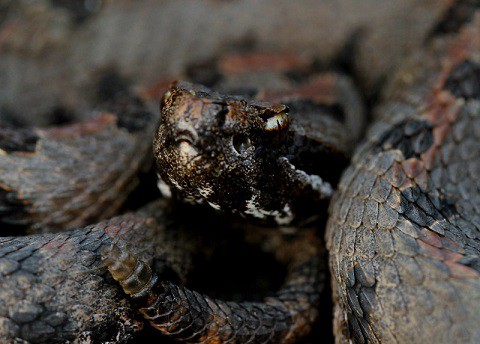
The main reason for the pygmy rattlesnake’s safety is its relatively low venom yield of 15-30mg. This cuts the amount of damage the venom can do in adults, but kids are much more vulnerable.
One example happened in October 2015, when the mother of 17 month old Blake Skinner noticed 4 fangs marks on his ankle. The snake was identified as a pygmy rattlesnake, and the boy whisked off to hospital. He was given 22 vials of conventional snake antivenom, but continued to fade away. The venom had eaten up almost all clotting materials in his bloodstream. Even a nosebleed could have been disastrous.
All seemed lost, but in a random flash of quick thinking, one doctor contacted the Oklahoma City Zoo. The man on the phone confirmed that they had a pygmy rattlesnake in stock, and the specific antivenom.
After a short but nervous wait, the antivenom was shipped over, and the boy was healed. “Doctor Banner and INTEGRIS and the zoo kind of made my heart beat come back”, said 17 month old Blake. By October 22nd 2015, 13 kids had been bitten by pygmy rattlesnakes in Oklahoma that year. In 2014, the total was four.
| 9 | Males defend their females |
Science has now proven that pygmy rattlesnakes live in a caring world where fellow snakes always courteous to each other. As usual, they begin their mating strategies by releasing irresistible pheromones into the air. The peak mating season is April-May, but with the pygmy rattlesnake, it’s first come first served. Male snakes never duke it out for a female, or wrestle in hour-long duels to prove their dominance like the cottonmouth or copperhead.
Once a male has bred with a female, the female will refuse to breed with others. Furthermore, the unlucky male snakes will give up and leave instantly, partly because the original male leaves a gelatinaceous plug that makes another breeding session impossible.
Once pregnant, the male and female will also stop breeding, but the male will hang around the rotten log or burrow, and fulfil his duty of “mate guarding”. He will protect the female from owls or racoons well into her pregnancy, for weeks or even months. The male and female will even curl around each other at night. It turns out that pygmy rattlesnakes more monogamous than some humans.
| 10 | Females defend their hatchlings |
The same is true for mother pygmy rattlesnakes. This species is ovoviviparous, giving birth to live young, and the numbers are below average, at 2-12 young compared to 10-20 for the west diamondback. The young are born in embryonic sacs which break open almost immediately.
For 7-10 days afterwards, the mother will guard her offspring. She won’t feed them milk or regurgitate half-digested food like a bird. The newborns are precocial and have to find insects and larvae for themselves, but like her male partner did in her moment of vulnerability, the mother rattlesnake will prevent predators from swooping down and carrying away her offspring. This week of harmony ends after the newborns’ first skin shedding, after which the mother leaves.
Sidewinder and timber rattlesnakes are also unusually caring, but not every member of the crew: west diamondbacks and black-tails abandon their young after a few hours.
